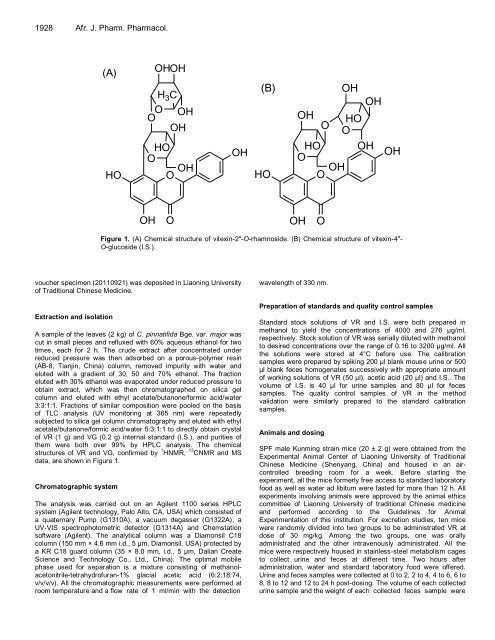Download Complete Issue (pdf 3800kb) - Academic Journals
Download Complete Issue (pdf 3800kb) - Academic Journals
Download Complete Issue (pdf 3800kb) - Academic Journals
You also want an ePaper? Increase the reach of your titles
YUMPU automatically turns print PDFs into web optimized ePapers that Google loves.
1928 Afr. J. Pharm. Pharmacol.<br />
(A)<br />
HO<br />
H3C O OH<br />
O<br />
OH<br />
HO<br />
O<br />
OH<br />
O<br />
OH<br />
OH OH<br />
O<br />
OH<br />
HO<br />
OH<br />
OH<br />
OH<br />
O<br />
HO<br />
O<br />
HO<br />
O<br />
OH<br />
O<br />
OH<br />
OH<br />
OH<br />
Figure 1. (A) Chemical structure of vitexin-2"-O-rhamnoside. (B) Chemical structure of vitexin-4"-<br />
O-glucoside (I.S.).<br />
voucher specimen (20110921) was deposited in Liaoning University<br />
of Traditional Chinese Medicine.<br />
Extraction and isolation<br />
A sample of the leaves (2 kg) of C. pinnatifida Bge. var. major was<br />
cut in small pieces and refluxed with 60% aqueous ethanol for two<br />
times, each for 2 h. The crude extract after concentrated under<br />
reduced pressure was then adsorbed on a porous-polymer resin<br />
(AB-8, Tianjin, China) column, removed impurity with water and<br />
eluted with a gradient of 30, 50 and 70% ethanol. The fraction<br />
eluted with 30% ethanol was evaporated under reduced pressure to<br />
obtain extract, which was then chromatographed on silica gel<br />
column and eluted with ethyl acetate/butanone/formic acid/water<br />
3:3:1:1. Fractions of similar composition were pooled on the basis<br />
of TLC analysis (UV monitoring at 365 nm) were repeatedly<br />
subjected to silica gel column chromatography and eluted with ethyl<br />
acetate/butanone/formic acid/water 5:3:1:1 to directly obtain crystal<br />
of VR (1 g) and VG (0.2 g) internal standard (I.S.), and purities of<br />
them were both over 99% by HPLC analysis. The chemical<br />
structures of VR and VG, confirmed by 1 HNMR, 13 CNMR and MS<br />
data, are shown in Figure 1.<br />
Chromatographic system<br />
The analysis was carried out on an Agilent 1100 series HPLC<br />
system (Agilent technology, Palo Alto, CA, USA) which consisted of<br />
a quaternary Pump (G1310A), a vacuum degasser (G1322A), a<br />
UV-VIS spectrophotometric detector (G1314A) and Chemstation<br />
software (Agilent). The analytical column was a Diamonsil C18<br />
column (150 mm × 4.6 mm i.d., 5 μm, Diamonsil, USA) protected by<br />
a KR C18 guard column (35 × 8.0 mm, i.d., 5 μm, Dalian Create<br />
Science and Technology Co., Ltd., China). The optimal mobile<br />
phase used for separation is a mixture consisting of methanolacetonitrile-tetrahydrofuran-1%<br />
glacial acetic acid (6:2:18:74,<br />
v/v/v/v). All the chromatographic measurements were performed at<br />
room temperature and a flow rate of 1 ml/min with the detection<br />
(B)<br />
O<br />
wavelength of 330 nm.<br />
Preparation of standards and quality control samples<br />
Standard stock solutions of VR and I.S. were both prepared in<br />
methanol to yield the concentrations of 4000 and 276 μg/ml,<br />
respectively. Stock solution of VR was serially diluted with methanol<br />
to desired concentrations over the range of 0.16 to 3200 μg/ml. All<br />
the solutions were stored at 4°C before use. The calibration<br />
samples were prepared by spiking 200 μl blank mouse urine or 500<br />
μl blank feces homogenates successively with appropriate amount<br />
of working solutions of VR (50 μl), acetic acid (20 μl) and I.S.. The<br />
volume of I.S. is 40 μl for urine samples and 80 μl for feces<br />
samples. The quality control samples of VR in the method<br />
validation were similarly prepared to the standard calibration<br />
samples.<br />
Animals and dosing<br />
SPF male Kunming strain mice (20 ± 2 g) were obtained from the<br />
Experimental Animal Center of Liaoning University of Traditional<br />
Chinese Medicine (Shenyang, China) and housed in an aircontrolled<br />
breeding room for a week. Before starting the<br />
experiment, all the mice formerly free access to standard laboratory<br />
food as well as water ad libitum were fasted for more than 12 h. All<br />
experiments involving animals were approved by the animal ethics<br />
committee of Liaoning University of traditional Chinese medicine<br />
and performed according to the Guidelines for Animal<br />
Experimentation of this institution. For excretion studies, ten mice<br />
were randomly divided into two groups to be administrated VR at<br />
dose of 30 mg/kg. Among the two groups, one was orally<br />
administrated and the other intravenously administrated. All the<br />
mice were respectively housed in stainless-steel metabolism cages<br />
to collect urine and feces at different time. Two hours after<br />
administration, water and standard laboratory food were offered.<br />
Urine and feces samples were collected at 0 to 2, 2 to 4, 4 to 6, 6 to<br />
8, 8 to 12 and 12 to 24 h post-dosing. The volume of each collected<br />
urine sample and the weight of each collected feces sample were

















